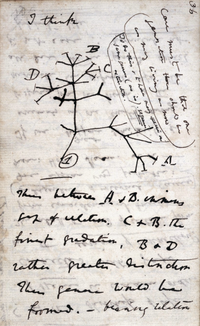
"Candidatus Mesenet longicola": Novel Endosymbionts of Brontispa longissima that Induce Cytoplasmic Incompatibility.
Sign Up to like & getrecommendations! Published in 2021 at "Microbial ecology"
DOI: 10.1007/s00248-021-01686-y
Abstract: Intracellular bacteria that are mainly transmitted maternally affect their arthropod hosts' biology in various ways. One such effect is known as cytoplasmic incompatibility (CI), and three bacterial species are known to induce CI: Wolbachia, Cardinium… read more here.
Keywords: cytoplasmic incompatibility; brontispa longissima; candidatus mesenet; mesenet longicola ... See more keywords

Wolbachia induce cytoplasmic incompatibility and affect mate preference in Habrobracon hebetor to increase the chance of its transmission to the next generation.
Sign Up to like & getrecommendations! Published in 2019 at "Journal of invertebrate pathology"
DOI: 10.1016/j.jip.2019.02.005
Abstract: Wolbachia are common intracellular bacteria that are generally found in arthropods, including a high proportion of insects and also some nematodes. This intracellular symbiont can affect sex ratio with a variety of reproductive anomalies in… read more here.
Keywords: cytoplasmic incompatibility; hebetor; wolbachia; habrobracon hebetor ... See more keywords

A Wolbachia infection from Drosophila that causes cytoplasmic incompatibility despite low prevalence and densities in males
Sign Up to like & getrecommendations! Published in 2018 at "Heredity"
DOI: 10.1038/s41437-018-0133-7
Abstract: Wolbachia bacteria are common insect endosymbionts transmitted maternally and capable of spreading through insect populations by cytoplasmic incompatibility (CI) when infected males cause embryo death after mating with uninfected females. Selection in the Wolbachia endosymbiont… read more here.
Keywords: cytoplasmic incompatibility; wolbachia; drosophila; wolbachia infection ... See more keywords

Effect of Quorum Sensing Inducers and Inhibitors on Cytoplasmic Incompatibility Induced by Wolbachia (Rickettsiales: Anaplasmataceae) in American Serpentine Leafminer (Diptera: Agromyzidae): Potential Tool for the Incompatible Insect Technique
Sign Up to like & getrecommendations! Published in 2022 at "Journal of Insect Science"
DOI: 10.1093/jisesa/ieab106
Abstract: Abstract Agricultural crops around the world are attacked by approximately 3,000–10,000 species of pest insect. There is increasing interest in resolving this problem using environmentally friendly approaches. Wolbachia (Hertig), an insect endosymbiont, can modulate host… read more here.
Keywords: incompatible insect; insect; insect technique; quorum sensing ... See more keywords

NDUFA8 potentially rescues Wolbachia-induced cytoplasmic incompatibility in Laodelphax striatellus.
Sign Up to like & getrecommendations! Published in 2023 at "Insect science"
DOI: 10.1111/1744-7917.13182
Abstract: The endosymbiont Wolbachia manipulates host reproduction by several strategies, one of the most important of which is cytoplasmic incompatibility (CI). CI can be rescued when Wolbachia-infected (WI) males mate with females infected with the same… read more here.
Keywords: wolbachia; striatellus; laodelphax striatellus; cytoplasmic incompatibility ... See more keywords

Transinfected Wolbachia strains induce a complex of cytoplasmic incompatibility phenotypes: Roles of CI factor genes.
Sign Up to like & getrecommendations! Published in 2023 at "Environmental microbiology reports"
DOI: 10.1111/1758-2229.13169
Abstract: Wolbachia can modulate the reproductive development of their hosts in multiple modes, and cytoplasmic incompatibility (CI) is the most well-studied phenotype. The whitefly Bemisia tabaci is highly receptive to different Wolbachia strains: wCcep strain from… read more here.
Keywords: wccep wmel; transinfected wolbachia; factor genes; wolbachia strains ... See more keywords

Wolbachia transinfections in Culex quinquefasciatus generate cytoplasmic incompatibility
Sign Up to like & getrecommendations! Published in 2019 at "Insect Molecular Biology"
DOI: 10.1111/imb.12604
Abstract: Culex quinquefasciatus is an important mosquito vector of a number of viral and protozoan pathogens of humans and animals, and naturally carries the endosymbiont Wolbachia pipientis, strain wPip. Wolbachia are used in two distinct vector… read more here.
Keywords: culex quinquefasciatus; wolbachia; transinfections culex; cytoplasmic incompatibility ... See more keywords

Transcriptome of Tetranychus urticae embryos reveals insights into Wolbachia‐induced cytoplasmic incompatibility
Sign Up to like & getrecommendations! Published in 2019 at "Insect Molecular Biology"
DOI: 10.1111/imb.12620
Abstract: The endosymbiont Wolbachia is known for manipulating host reproduction in selfish ways. However, the molecular mechanisms have not yet been investigated in embryos. Here, we found that Wolbachia had no effect on the number of… read more here.
Keywords: cytoplasmic incompatibility; tetranychus urticae; wolbachia induced; embryos ... See more keywords

The CinB Nuclease from wNo Wolbachia Is Sufficient for Induction of Cytoplasmic Incompatibility in Drosophila
Sign Up to like & getrecommendations! Published in 2022 at "mBio"
DOI: 10.1128/mbio.03177-21
Abstract: Wolbachia species are bacteria that live within the cells of many insects. Like mitochondria, they are only inherited from females. Wolbachia often increases the number of infected females to promote spread of infection using a… read more here.
Keywords: wolbachia; expression; cytoplasmic incompatibility; cinb ... See more keywords

Loss of cytoplasmic incompatibility in Wolbachia-infected Aedes aegypti under field conditions
Sign Up to like & getrecommendations! Published in 2019 at "PLoS Neglected Tropical Diseases"
DOI: 10.1371/journal.pntd.0007357
Abstract: Wolbachia bacteria are now being introduced into Aedes aegypti mosquito populations for dengue control. When Wolbachia infections are at a high frequency, they influence the local transmission of dengue by direct virus blocking as well… read more here.
Keywords: field; density; wolbachia; cytoplasmic incompatibility ... See more keywords

Pangenomic analysis of Wolbachia provides insight into the evolution of host adaptation and cytoplasmic incompatibility factor genes
Sign Up to like & getrecommendations! Published in 2023 at "Frontiers in Microbiology"
DOI: 10.3389/fmicb.2023.1084839
Abstract: Introduction The genus Wolbachia provides a typical example of intracellular bacteria that infect the germline of arthropods and filarial nematodes worldwide. Their importance as biological regulators of invertebrates, so it is particularly important to study… read more here.
Keywords: host adaptation; wolbachia; evolution; host ... See more keywords